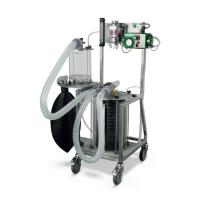6
USER MANUAL LAVC
-
2000
-
D ANAESTHETIC MACHINE
T +49 7461 96 580 0 | F + 49 7461 96 580 90 | export@eickemeyer.com | www.eickemeyer.com
Note: Special care should be taken with this control. It is the control that is used to assist the patient in breathing. If set to
high (making it more diffi cult for the patient to cycle on the machine) the patient will have a decreased breathing rate and
possible more serious circumstances could result. The sensitivity can be set to low causing the Servo to auto-cycle at a rapid
rate. The sensitivity should be adjusted so that a negative defl ection on the manometer (located on the Servo) indicates
approximately -2 / -3 cmH₂O before the Servo cycles on. The size and condition of the patient should be taken into consideration
as the larger animal, in most cases, can exert more inspiratory effort than the smaller animal. Higher numbers increase the
amount of effort required to cycle on the machine.
4. Inspiratory Pressure Lever
This control is located on the right side of the Servo and is clearly marked. The normal setting for clinical evaluation should
be 15 – 20 cmH₂O. It is impossible to determine a setting that is suffi cient for all patients. The operator should perform a
clinical evaluation by monitoring the chest excursion. Care should be taken not to over-infl ate the lungs.
Note: Many leading large animal practitioners recommend that after a patient has been ventilated for 15 – 30 minutes a sigh,
or a deep breath, be administered. This is accomplished by increasing the pressure setting. For example, if the preset pressure
is 20 cmH₂O, after 15 – 30 minutes of ventilation the patient should be given a sign breath of 25 cmH₂O. Some large animal
practitioners elect to increase the sigh breath to 45 – 50 cmH₂O. EICKEMEYER® recommends a 25 cmH₂O sigh breath from
20 cmH₂O normal setting.
5. Expiratory Timer or Apnea Control
This is the control that enables the clinician to dial in a rate of breathing. If the patient becomes apneic, the operator will
open this control in counter-clockwise direction to start the automatic timer. Opening the knob counter- clockwise increases
the breathing rate. Turning clockwise slows the breathing rate. This control allows a rate selection of approximately 2 breaths
per minute to 30 breaths per minute.
The expiratory timer has several additional functions that offer many safety features to the anesthetic process, such as:
a. If the operator is using the ventilator in the assist mode, the patient must exert an effort to cycle on the machine.
b. When the machine is used in the assist mode and the expiratory timer is adjusted to the minimum number of breaths, a
margin of safety is added to the spontaneously breathing patient; i. e., if the normally breathing patient can exert an
inspiratory effort the Servo senses it and cycles off. But, if the patient becomes apneic and the operator had adjusted the
apnea control prior to the procedure (slightly open position), the machine now is in an automatic function mode that will
take over if the patient fails to exert the inspiratory effort before the automatic interval takes over.
c. The operator also has the choice of complete control over the patient by increasing the sensitivity to a point just above the
maximum amount of effort the patient is able to exert and using the apnea control to give the patient the selected number
of breaths per minute.
6. Hand Timer
The hand timer is located in the center of the sensitivity control. It is a small red plastic shaft protruding one half inch from
the left side of the modifi ed Mark 7 Servo. This control is used to deliver a breath at any time that the operator wishes. Push
in the red shaft; when the Servo reaches the preset pressure, the shaft will return to the off, or out, position.
7. Manometer
The manometer is located on the face of the modifi ed Mark 7 Servo. It measures in both cmH₂O and mmHg. The manometer
is connected directly to the patient breathing circuit and monitors the inspiratory pressure delivered to the patient.

